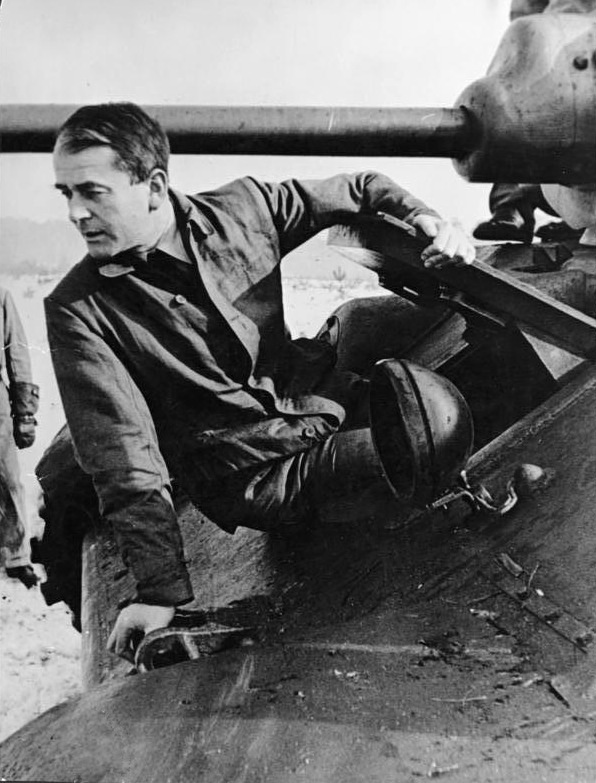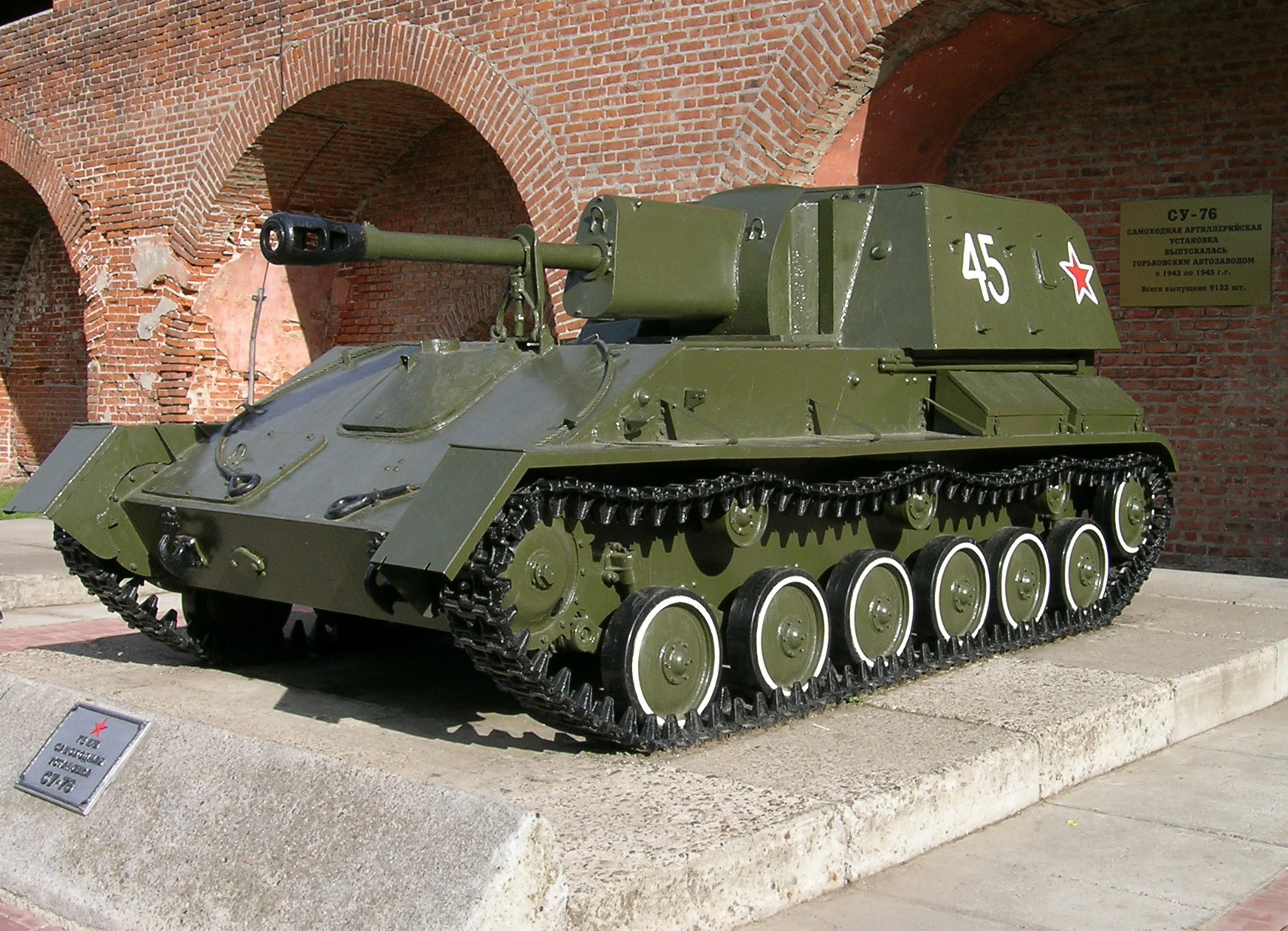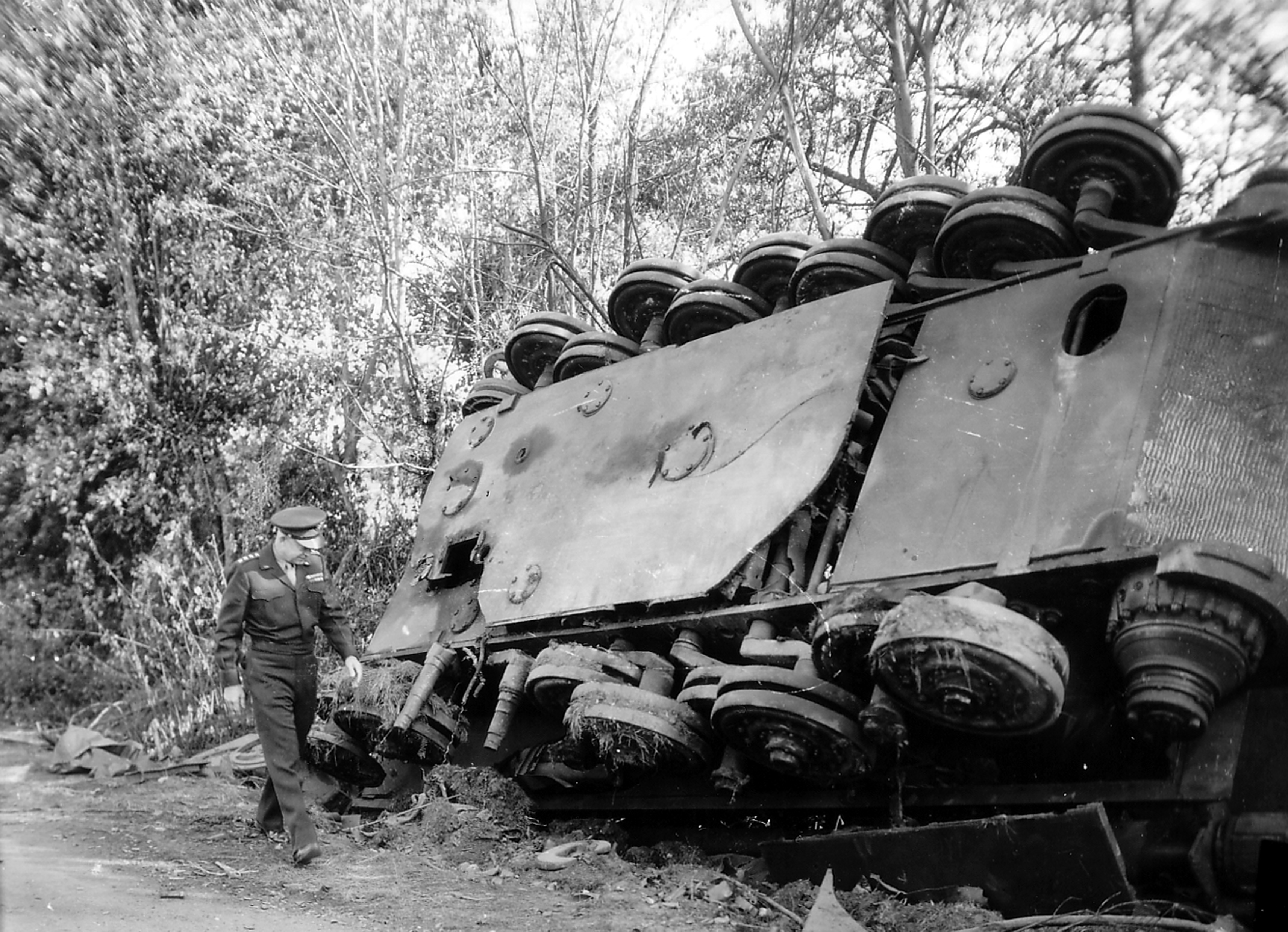|
SS Brigade Westfalen
The SS Brigade Westfalen also known as SS Ersatz Brigade Westfalen was an ad hoc unit composed of the men of the military training commands of the Paderborn area and the 507th Heavy Panzer Battalion. The unit was committed into battle in March 1945 in an unsuccessful attempt to stop American troops from encircling Army Group B in the Ruhr Pocket. History The brigade was formed on 29 March 1945 from training staff and other personnel at Sennelager Training Grounds north of Paderborn. The unit consisted of two improvised infantry regiments that were named after their commanders. Regiment "Meyer" consisted of three battalions: SS Panzer Reconnaissance Training and Replacement Battalion 1, SS Panzer Reconnaissance Training and Replacement Battalion 2, and an SS Panzer Reconnaissance NCO Training Battalion. Regiment "Holzer" was named after its commander Obersturmbannführer Friedrich Holzer and consisted of the SS Panzer Training and Replacement Regiment in Augustdorf, which consists ... [...More Info...] [...Related Items...] OR: [Wikipedia] [Google] [Baidu] |
Flag Schutzstaffel
A flag is a piece of textile, fabric (most often rectangular or quadrilateral) with a distinctive design and colours. It is used as a symbol, a signalling device, or for decoration. The term ''flag'' is also used to refer to the graphic design employed, and flags have evolved into a general tool for rudimentary signalling and identification, especially in environments where communication is challenging (such as the Maritime flag, maritime environment, where Flag semaphore, semaphore is used). Many flags fall into groups of similar designs called flag families. The study of flags is known as "vexillology" from the Latin , meaning "flag" or "banner". National flags are patriotic symbols with widely varied interpretations that often include strong military associations because of their original and ongoing use for that purpose. Flags are also used in messaging, advertising, or for decorative purposes. Some military units are called "flags" after their use of flags. A ''flag'' ( ... [...More Info...] [...Related Items...] OR: [Wikipedia] [Google] [Baidu] |
Panther Tank
The Panther tank, officially ''Panzerkampfwagen V Panther'' (abbreviated PzKpfw V) with ordnance inventory designation: ''Sd.Kfz.'' 171, is a German medium tank of World War II. It was used on the Eastern and Western Fronts from mid-1943 to the end of the war in May 1945. On 27 February 1944 it was redesignated to just ''PzKpfw Panther'', as Hitler ordered that the Roman numeral "V" be deleted. In contemporary English-language reports it is sometimes referred to as the "Mark V". The Panther was intended to counter the Soviet T-34 medium tank and to replace the Panzer III and Panzer IV. Nevertheless, it served alongside the Panzer IV and the heavier Tiger I until the end of the war. It had excellent firepower, protection and mobility, although its reliability was less impressive. The Panther was a compromise. While having essentially the same Maybach V12 petrol (690 hp) engine as the Tiger I, it had better gun penetration, was lighter and faster, and could traverse roug ... [...More Info...] [...Related Items...] OR: [Wikipedia] [Google] [Baidu] |
Waffen-SS Brigades
The (, "Armed SS") was the combat branch of the Nazi Party's ''Schutzstaffel'' (SS) organisation. Its formations included men from Nazi Germany, along with volunteers and conscripts from both occupied and unoccupied lands. The grew from three regiments to over 38 divisions during World War II, and served alongside the German Army (''Heer''), ''Ordnungspolizei'' (uniformed police) and other security units. Originally, it was under the control of the (SS operational command office) beneath Heinrich Himmler, the head of the SS. With the start of World War II, tactical control was exercised by the (OKW, "High Command of the Armed Forces"), with some units being subordinated to (Command Staff Reichsführer-SS) directly under Himmler's control. Initially, in keeping with the racial policy of Nazi Germany, membership was open only to people of Germanic origin (so-called " Aryan ancestry"). The rules were partially relaxed in 1940, and after the Operation Barbarossa invasion o ... [...More Info...] [...Related Items...] OR: [Wikipedia] [Google] [Baidu] |
Weser
The Weser () is a river of Lower Saxony in north-west Germany. It begins at Hannoversch Münden through the confluence of the Werra and Fulda. It passes through the Hanseatic city of Bremen. Its mouth is further north against the ports of Bremerhaven and Nordenham. The latter is on the Butjadingen Peninsula. It then merges into the North Sea via two highly saline, estuarine mouths. It connects to the canal network running east-west across the North German Plain. The river, when combined with the Werra (a dialectal form of "Weser"), is long and thus, the longest river entirely situated within Germany (the Main, however, is the longest if the Weser and Werra are not combined). The Weser itself is long. The Werra rises in Thuringia, the German state south of the main projection (tongue) of Lower Saxony. Etymology "Weser" and "Werra" are the same words in different dialects. The difference reflects the old linguistic border between Central and Low German, passing through H ... [...More Info...] [...Related Items...] OR: [Wikipedia] [Google] [Baidu] |
Assault Gun
Assault gun (from german: Sturmgeschütz - "storm gun", as in "storming/assaulting") is a type of self-propelled artillery which uses an infantry support gun mounted on a motorized chassis, normally an armored fighting vehicle, which are designed to provide direct fire support for infantry attacks, especially against other infantry or fortified positions. Assault guns were pioneered by the Soviet Union and Nazi Germany during the 1930s, initially being self-propelled guns with direct fire in mind (such as the Soviet SU-5-1), with Germany introducing the first purpose-built (and purpose-named) assault gun, the Sturmgeschütz III, in 1940. Historically, the concept of assault guns was very similar to that of the infantry tank, as both were combat vehicles intended to accompany infantry formations into battle. However, during World War II assault guns were more mobile than tanks and could be utilized as both direct and indirect fire artillery. Although they could approximate the fi ... [...More Info...] [...Related Items...] OR: [Wikipedia] [Google] [Baidu] |
US 3rd Armored Division
The 3rd Armored Division (also known as "Spearhead", 3rd Armored, and 3AD) was an armored division of the United States Army. Unofficially nicknamed the "Third Herd," the division was first activated in 1941 and was active in the European Theater of World War II. The division was stationed in West Germany for much of the Cold War and also participated in the Persian Gulf War. On 17 January 1992, still in Germany, the division ceased operations. In October 1992, it was formally inactivated as part of a general drawing down of U.S. military forces at the end of the Cold War. World War II Composition The 3rd Armored Division was organized as a "heavy" armored division, as was its counterpart, the 2nd Armored Division ("Hell on Wheels"). Later on in World War II, higher-numbered U.S. armored divisions were made smaller, with a higher ratio of armored infantry to tanks, based on lessons learned from fighting in North Africa. As a "heavy" division, the 3rd Armored commanded two ... [...More Info...] [...Related Items...] OR: [Wikipedia] [Google] [Baidu] |
Jagdpanther
The ''Jagdpanther'' (German: "hunting Panther"), Sd.Kfz. 173, was a tank destroyer (''Jagdpanzer'', a self-propelled anti-tank gun) built by Germany during World War II. The ''Jagdpanther'' combined the 8.8 cm Pak 43 anti-tank gun, similar to the main gun of the Tiger II, and the armor and suspension of the Panther chassis. It entered service in 1944 and served on the Eastern and Western Fronts. During the last stages of the war, limited German production resulted in small production numbers, shortage of spare parts, and shortened crew training periods of younger operators. Development The Jagdpanther was preceded by two attempts at mounting an 8.8 cm gun as a self-propelled anti-tank weapon; ''Ferdinand'' - also known as ''Panzerjäger Tiger'' (P) - using the ninety-one leftover Porsche-built VK 45.01 (P) chassis from the Tiger tank competition it lost to Henschel in 1942, and the ''Nashorn'' on the Geschützwagen III/IV (which used a combination of the Panzer ... [...More Info...] [...Related Items...] OR: [Wikipedia] [Google] [Baidu] |
Panzer III
The ''Panzerkampfwagen III'', commonly known as the Panzer III, was a medium tank developed in the 1930s by Germany, and was used extensively in World War II. The official German ordnance designation was Sd.Kfz. 141. It was intended to fight other armoured fighting vehicles and serve alongside and support the similar Panzer IV, which was originally designed for infantry support. However, as the Germans faced the formidable T-34, more powerful anti-tank guns were needed, and since the Panzer IV had more development potential with a larger turret ring, it was redesigned to mount the long-barrelled 7.5 cm KwK 40 gun. The Panzer III effectively swapped roles with the Panzer IV, as from 1942 the last version of the Panzer III mounted the 7.5 cm KwK 37 L/24 that was better suited for infantry support. Production of the Panzer III ceased in 1943. Nevertheless, the Panzer III's capable chassis provided hulls for the Sturmgeschütz III assault gun until the end of the war. Development h ... [...More Info...] [...Related Items...] OR: [Wikipedia] [Google] [Baidu] |
Steven Zaloga
Steven J. Zaloga (born February 1, 1952) is an American author and defense consultant. He received a bachelor's degree '' cum laude'' at Union College and a master's degree at Columbia University, both in history. He has published many books dealing with modern military technology, and especially Soviet and CIS tanks and armoured warfare. He is a senior analyst at the Teal Group. He is also a noted scale armor modeler and is a host/moderator of the World War II Allied Discussion group at Missing-Lynx.com, a modelling website. He is a frequent contributor to the UK-based modeling magazine ''Military Modelling''. He is a member of the Armor Modeling and Preservation Society The Armor Modeling and Preservation Society (AMPS) is a social club with the common interest of modeling miniature armored fighting vehicles, military model figures, ordnance, dioramas, and related equipment and promotion of historic military veh .... Works * * * * * * * * * * * * * * * ... [...More Info...] [...Related Items...] OR: [Wikipedia] [Google] [Baidu] |
Charles B
Charles is a masculine given name predominantly found in English and French speaking countries. It is from the French form ''Charles'' of the Proto-Germanic name (in runic alphabet) or ''*karilaz'' (in Latin alphabet), whose meaning was "free man". The Old English descendant of this word was '' Ċearl'' or ''Ċeorl'', as the name of King Cearl of Mercia, that disappeared after the Norman conquest of England. The name was notably borne by Charlemagne (Charles the Great), and was at the time Latinized as ''Karolus'' (as in ''Vita Karoli Magni''), later also as '' Carolus''. Some Germanic languages, for example Dutch and German, have retained the word in two separate senses. In the particular case of Dutch, ''Karel'' refers to the given name, whereas the noun ''kerel'' means "a bloke, fellow, man". Etymology The name's etymology is a Common Germanic noun ''*karilaz'' meaning "free man", which survives in English as churl (< Old English ''ċeorl''), which developed its depr ... [...More Info...] [...Related Items...] OR: [Wikipedia] [Google] [Baidu] |
Tiger II
The Tiger II is a German heavy tank of the Second World War. The final official German designation was ''Panzerkampfwagen'' Tiger ''Ausf''. B,'' Panzerkampfwagen'' – abbr: ''Pz.'' or ''Pz.Kfw.'' (English: "armoured fighting vehicle"), ''Ausf.'' is abbreviation of ''Ausführung'' (English: variant). The full titles ''Panzerkampfwagen'' Tiger ''Ausf''. B and ''Panzerbefehlswagen'' Tiger ''Ausf''. B (for the command version) were used in training and maintenance manuals and in organisation and equipment tables. (Jentz and Doyle 1997). Also sometimes referred to as "Pz. VI ''Ausf'' B", not to be confused with "Pz. VI ''Ausf'' E”, which was the Tiger I. often shortened to Tiger B.Jentz and Doyle 1993, p. 16. The ordnance inventory designation was ''Sd.Kfz.'' 182. ( ''Sd.Kfz.'' 267 and 268 for command vehicles). It was known as King Tiger by Allied soldiers, and is also known under the informal name ''Königstiger'' (the German name for the Bengal tiger which translates literally a ... [...More Info...] [...Related Items...] OR: [Wikipedia] [Google] [Baidu] |
Waffen-SS
The (, "Armed SS") was the combat branch of the Nazi Party's ''Schutzstaffel'' (SS) organisation. Its formations included men from Nazi Germany, along with Waffen-SS foreign volunteers and conscripts, volunteers and conscripts from both occupied and unoccupied lands. The grew from three regiments to over 38 division (military), divisions during World War II, and served alongside the German Army (Wehrmacht), German Army (''Heer''), ''Ordnungspolizei'' (uniformed police) and other security units. Originally, it was under the control of the (SS operational command office) beneath Heinrich Himmler, the head of the SS. With the start of World War II, tactical control was exercised by the (OKW, "High Command of the Armed Forces"), with some units being subordinated to (Command Staff Reichsführer-SS) directly under Himmler's control. Initially, in keeping with the racial policy of Nazi Germany, membership was open only to people of Germanic origin (so-called "Nazi racial theor ... [...More Info...] [...Related Items...] OR: [Wikipedia] [Google] [Baidu] |







